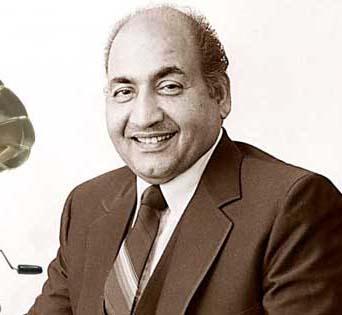
| Name |
Mohammed Rafi |
| Height |
|
| Naionality |
Indian |
| Date of Birth |
24 December 1924 |
| Place of Birth |
Mumbai, Maharashtra, India |
| Famous for |
Singing |
Mohammed Rafi was born the second youngest of six sons of Hajji Ali Mohammad at Kotla Sultan Singh, a village near Amritsar in Punjab (British India).Rafi, whose nickname was Pheeko, started singing by imitating chants of a fakir in his village.Rafi's father moved to Lahore in the Nineteen Twenties and owned a men's salon in Noor Mohalla in Bhatti Gate Lahore.It was his elder brother (Mohammad Deen's) friend Abdul Hameed who later became his brother in law, who spotted the talent in Rafi in Lahore and encouraged him to sing. Abdul Hameed later convinced the family elders to let him move to Bombay and he accompanied Mohammad Rafi to Bombay in 1944. Rafi learnt classical music from Ustad Bade Ghulam Ali Khan, Ustad Abdul Wahid Khan, Pandit Jiwanlal Matto and Firoze Nizami.
Rafi's first public performance came at the age of 13, when he was allowed to sing at a concert in Lahore featuring K. L. Saigal.In 1941, Rafi, under Shyam Sunder, made his debut in Lahore as a playback singer in the duet "Soniye nee, Heeriye nee" with Zeenat Begum in the Punjabi film Gul Baloch (the film was released in 1944).In that same year, Rafi was invited by All India Radio Lahore station to sing for them.He made his professional debut in the Shyam Sunder-directed 1941 film Gul Baloch and the Bombay film, Gaon Ki Gauri, the following year.
Advent in Mumbai
In 1944, Rafi moved to Bombay (now Mumbai),The brother in laws to be took up a ten-by-ten-feet room in the crowded downtown Bhendi Bazar area. Here poet Tanvir Naqvi introduced him to some of film producers including Abdur Rashid Kardar, Mehboob Khan and actor-director Nazeer.Shyam Sunder was in Mumbai and again provided an opportunity to Rafi – who got to sing a duet with GM Durrani, ‘Aji dil ho qaabu mein to dildar ki aisi taisi…’, for Gaon Ki Gori, which became Rafi’s first recorded song in a Hindi film. Many other songs followed.Rafi also did brief roles in movies like Laila-Majnu (1945) and Jugnu. In Laila-Majnu, he was seen singing Tera Jalwa as a part of the chorus.
In 1948, after the assassination of Mahatma Gandhi, the team of Husanlal Bhagatram-Rajendra Krishan-Rafi had overnight created the song ‘Suno suno ae duniyawalon, Bapuji ki amar kahani…’.He was invited by the Indian Prime Minister, Jawaharlal Nehru, to sing at the latter's house. In 1948, Rafi received a silver medal from Nehru on the Indian Independence Day. In 1949, Rafi was given solo songs by music directors such as Naushad, (Chandni Raat, Dillagi and Dulari) Shyam Sunder (Bazaar) and Husnalal Bhagatram (Meena Bazaar).
Rafi's first song with Naushad was "Hindustan ke hum hain" with Shyam Kumar, Alauddin and others, from A. R. Kardar's Pehle Aap (1944). Around the same time, Rafi recorded another song for the 1945 film Gaon ki Gori, "Aji dil ho kaaboo mein". He considered this song his first Hindi language song.
Rafi also appeared in two movies. In 1945, Rafi appeared on the screen for the song "Tera Jalwa Jis Ne Dekha" in the film Laila Majnu.He sang a number of songs for Naushad as part of the chorus, including "Mere sapnon ki rani, Roohi Roohi" with K. L. Saigal from the film Shahjahan (1946). Rafi sang "Tera Khilona Toota Balak" from Mehboob Khan's Anmol Ghadi (1946) and a duet with Noor Jehan in the 1947 film Jugnu, "Yahan Badla Wafa Ka". Following the Partition of India, Rafi decided to stay in India and had his family flown to Bombay. Whereas Noor Jahan migrated to Pakistan and made a pair with playback singer Ahmed Rushdi.
Rafi was highly influence by the singers of that time like K. L Saigal, Talat Mehmood and, most notably, by G. M. Durrani - on whose style he based his singing. He sung with his idol in some of the songs such as "Humko Hanste Dekh Zamana Jalta Hai (Hum Sab Chor Hain, 1956)and "Khabar Kisi ko Nahiin, woh kidhar Dekhte (Beqasoor, 1950),etc.c.
